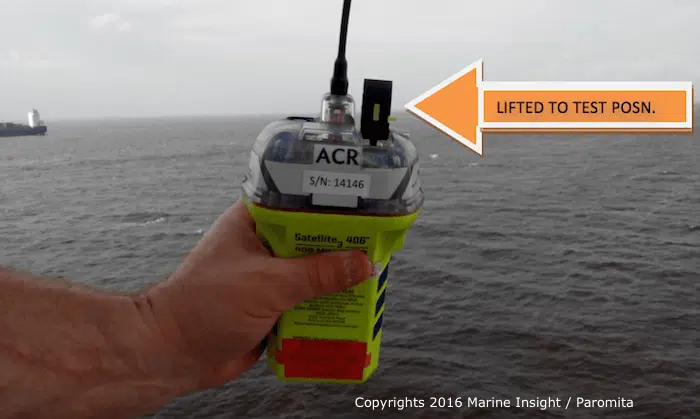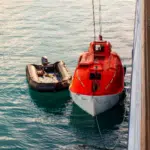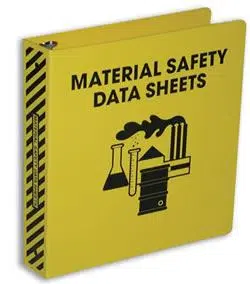What is An Emergency Position Indicating Radio Beacon (EPIRB)?
Emergency Position Indicating Radio Beacon (EPIRB) is a device to alert search and rescue services (SAR) in case of an emergency out at sea. It is tracking equipment that transmits a signal on a specified band to locate a lifeboat, life raft, ship or people in distress.
They are installed on ships and other vessels after being registered with the national search and rescue forces to that boat. The registration allows confirmation of false alerts and faster and quicker rescue operations in emergencies.
An EPIRB is a SECONDARY means of DISTRESS alerting, which means that it comes later in the hierarchy of alerting SAR authorities in case of distress.
It is mandatory to carry one EPIRB on every ship and two EPIRBS for all Registered ships (and other types of vessels).
Types Of EPIRB
- COSPAS-SARSAT– EPIRBS under the COSPAS-SARSAT system work on the 406.025 MHz and 121.5 MHz bands and are applicable for all sea areas
- INMARSAT E– This EPIRB works on a 1.6 GHz band. These are applicable for sea areas A1, A2 and A3.
- VHF CH 70– This works on the 156.525 MHz band and is applicable for sea area A1 only
How Does An EPIRB Work?
The device contains two radio transmitters, a 5-watt one and a 0.25-watt one, each operating at 406 MHz, the standard international frequency typically signalling distress, 406MHz.
The 5-watt radio transmitter is synchronised with a GOES weather satellite going around the earth in a geosynchronous orbit.
The COSPAS-SARSAT is an international satellite-based search and rescue system founded by the U.S., Russia, Canada and France to detect emergency radio beacons.
Due to the many advantages of 406 MHz beacons and the disadvantages of the 121.5 MHz beacons, the International Cospas-Sarsat Program stopped the satellite processing of 121.5 MHz by satellites on February 1st, 2009. Encouragements were given by the National Oceanic and Atmospheric Administration/ NOAA and FAA to switch to 406 for obvious reasons.
However, aircraft might still use the Emergency Locator Transmitter, and alerts from these devices would not be acted upon unless confirmed by two other independent non-satellite sources or devices.
An EPIRB transmits signals to the satellite. The signal consists of an encrypted identification number (all in digital code), which holds information such as the ship’s identification, event date, the nature of distress, emergency contacts and position.
A UIN is a Unique Identifier Number programmed into each beacon at the factory. The UIN number consists of a 15-digit series of letters and numbers that make up the unique identity of the beacon. The UIN is on a white label on the exterior of the beacon. The UIN is also referred to as the Hex ID.
The Local User Terminal (satellite receiving units or ground stations) calculates the position of the casualty using Doppler Shift (which is the change in frequency or wavelength of a wave (or other periodic events) for an observer moving relative to its source).
The LUT passes the digital message to the MRCC (Mission Rescue Co-Ordination Centre). Furthermore, the MRCC is responsible for the SAR ops and oversees the execution of the rescue mission.
If the EPIRB is not compatible with a GPS receiver, the geosynchronous satellite orbiting the earth can pick up only the radio signals emitted by the radio. In this case, the location of the transmitter or the identity of the owner cannot be deduced.
These satellites can only pick up trace elements of such signals and can only give a rough idea of the location of the EPIRB. Per international standards, a signal of 406MHz is treated as an emergency signal.
The signal could help you locate the transmitter, even if it is 3 miles away. If the EPIRB is registered, the vessel or the individual in distress could be identified.
If an emitter transmits signals of 121.5 MHz, the rescuer or concerned party can reach the lost person even if they are 15 miles away. The accuracy of reaching the target could be magnified if an EPIRB also contains a GPS receiver.
Using an EPIRB
The EPIRB needs to be activated to emit signals by the beacon owner. In the case of category II EPIRBs, this could be done by pushing a button on the unit, or it could happen automatically if and when it comes in contact with water through hydrostatic release.
The latter is known as a hydrostatic EPIRB. Its quality makes it the best choice for sailors because it can be automatically activated in case the ship or vessel encounters an accident and finds itself in deep waters.
The point to be kept in mind is that EPIRB needs activation to be operative, and this could happen only when it emerges from the bracket it is placed in. As said earlier, this could be done manually or happen automatically. The device is essentially battery-operated. This helps because power is the first entity to be affected in case of a calamity.
Battery
- 12 Volt battery
- 48 hours of transmitting capacity
- Normally replaced every 2 to 5 years
- Use proper replacement battery
False Alerting
An individual onboard might mistakenly activate the EPIRB and send false alarms. If this happens, the nearest coast station or RCC (Rescue Co-Ordination Center) must be informed immediately and canceled.
The cancellation intimation must also be sent to the appropriate authority (for example, DG Shipping for Indian Registered Ships or ships plying in Indian waters when the false alert is transmitted). The shipowner and/or the agent must also be informed.
Testing EPIRB
The EPIRB should be tested once a month to ensure operational integrity. The procedure to do so is as follows:
- Press and release the test button on the EPIRB
- The red lamp on the EPIRB should flash once
- Within 30 seconds of pressing the button, the strobe, as well as the red light, should flash several times
- After 60 seconds of operation, the EPIRB will switch off
Maintenance of EPIRB
- The EPIRB must be inspected visually for any defects such as cracks
- It is advisable to clean the EPIRB once in a while with a dry cloth
- While cleaning, the switches must be specifically checked
- The lanyard of the EPIRB must be neatly packed into the container of the EPIRB without any loose ends dangling about
- The expiry date of the battery must be checked to cover the immediate as well as the next voyage at the least
- Send the EPIRB back to the service agent or the supplier if the EPIRB fails the monthly checks
- Change the battery onboard if the facilities are available or send it to the servicing agent if there isn’t
- If the EPIRB has been used in an emergency, it must be returned to an authorised service agent for a battery change.
- If the HRU has crossed its expiry date, the HRU ought to be replaced on board, and HRU must be marked with an expiry date two years into the future.
PLBs (Personal Locator Beacons)
PLBs are EPIRBs for individual entities. They indicate distress for an individual not in the proximity of emergency services. PLBs work like EPIRBS and transmit on the COSPAS SARSAT satellite system at 406.025 MHz. They are much smaller in size than EPIRBs. They work all over the world, at sea and on land.
They should be kept in a safe place on the vessel, in a ditch bag, or in an easily accessible spot. Some have strobe lights that can be manually or automatically activated.
Once activated, PLBs transmit for a minimum of 24 hours, while the battery life on an EPIRB is at least double (a minimum of 48 hours). An EPIRB is registered to a vessel, whereas a PLB is registered to an individual.
The EPIRB is an essential emergency equipment available onboard in case of distress. It must be given considerable time to care for, test, and maintain itself so that it functions at its optimum level when the situation arises.
You might also like to read:
- Liferafts: SOLAS Requirements, Safety Features & Launching Procedure
- Safety of Life at Sea (SOLAS); The Ultimate Guide
- Daily, Monthly And Weekly Tests Of GMDSS Equipment On Board Ships
- What is Search and Rescue Transponder (SART)?
- Types of Life-Saving Equipment Onboard Ships
Disclaimer: The author’s views expressed in this article do not necessarily reflect the views of Marine Insight. Data and charts, if used in the article, have been sourced from available information and have not been authenticated by any statutory authority. The author and Marine Insight do not claim it to be accurate nor accept any responsibility for the same. The views constitute only the opinions and do not constitute any guidelines or recommendations on any course of action to be followed by the reader.
The article or images cannot be reproduced, copied, shared or used in any form without the permission of the author and Marine Insight.
Do you have info to share with us ? Suggest a correction
Latest Ship Safety Articles You Would Like:

About Author
Shilavadra Bhattacharjee is a shipbroker with a background in commercial operations after having sailed onboard as a Third Officer. His interests primarily lie in the energy sector, books and travelling.
Subscribe To Our Newsletters
By subscribing, you agree to our Privacy Policy and may receive occasional deal communications; you can unsubscribe anytime.























cool more ,, idea and summary to learn
Better than Wikipedia, i salute you sir.
@Geoffrey: ??
Seriously the information is better than wikpedia and other leading websites
Note the Inmarsat 1.6 GHz EPIRB has ceased operation since 1 Dec 2006 (though it’s still referred to in the SOLAS convention).
Sir can you please tell me the number of EPIRB onboard?
Interesting
I am a public school teacher in senior high school maritime tract. we do not have available resources for maritime articles. Your site really help us a lot to equip our maritime students to be a future marine officers. we are very thankful for everything you’ve dine for your aspirants like us. Thank you and more power on your group.
it was usefull for me so thx
I work at an RCC and the information is overall good but not completely accurate. VHF-DSC is not an EPIRB not is INMARSAT. EPIRBs are also not a secondary distress.
Thank you for the comment Rabjot
👍
@Marlon It will be wonderful if we can connect with the student for a guest session 🙂
Glad to know this Sanginan
1. There comes a special type of EPIRB called VHF-DSC EPIRB. This is used by vessels trading exclusively within A1 areas to carry an EPIRB operating on VHF channel 70 in lieu of a 406 MHz EPIRB.
However, this is a type of EPIRB that is seldom used.
2. Regarding EPIRB as secondary means of alerting, it is said so because usually the initial distress alerts are sent through the terrestrial (VHF, MF, HF) or Satellite (INMARSAT) system. Yes, EPIRB is also equally important in emergencies but we have written it as secondary for the sake of distinction as it works on a different system alltogether.